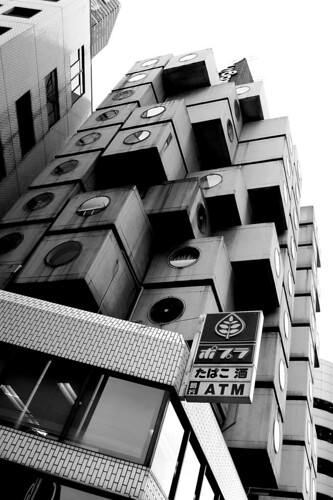Future Now
The IFTF Blog
The architecture of the future
The New York Times has a piece (Future Vision Banished to the Past") about the likely destruction of Kisho Kurokawa’s Nakagin Capsule Tower, a "rare built example of Japanese Metabolism, a movement whose fantastic urban visions became emblems of the country’s postwar cultural resurgence." It's a piece that raises some interesting questions for futurists as well as architects and preservationists.

Nakagin Capsule Tower, from the New York Times
The building, built in 1972, is now in lousy shape (what a surprise for an architecturally distinctive building employing innovative construction technology), but the author argues that
the building’s demolition would be a bitter loss. The Capsule Tower is not only gorgeous architecture; like all great buildings, it is the crystallization of a far-reaching cultural ideal. Its existence also stands as a powerful reminder of paths not taken, of the possibility of worlds shaped by different sets of values.
Founded by a loose-knit group of architects at the end of the 1950s, the Metabolist movement sought to create flexible urban models for a rapidly changing society. Floating cities. Cities inspired by oil platforms. Buildings that resembled strands of DNA. Such proposals reflected Japan’s transformation from a rural to a modern society. But they also reflected more universal trends, like social dislocation and the fragmentation of the traditional family, influencing generations of architects from London to Moscow.
Like lots of twentieth-century architectural movements, the Metabolists were at least as influential for their ideas as their actual buildings. A lot of the more outlandish ideas from this period were never meant to be built-- drawings of walking cities were stimulating reflections on the nature of building in an impermanent world, but totally impractical-- but they made other, more prolific architects think differently about their work and the issues it raises. And they were arguably one of the most important advocates of a "lightweight infrastructure" approach to architecture, one that emphasized modularity, scalability, and standardization.

Nakagin Capsule Tower, photo by dod: via flickr
I wonder if there's a useful comparison to be drawn between movements like these, or projects that remain forever on the drawing board but get talked about, and futurists and their work. Most of us don't build things, or write software, or craft strategies; the scenarios we write are intended to be provocations or stimulations (a hedge against them being wrong, which to one degree or another they inevitably are), and at best we have an indirect but positive influence on other people.
Composed of 140 concrete pods plugged into two interconnected circulation cores, the structure was meant as a kind of bachelor hotel for businessmen working in the swanky Ginza neighborhood of Tokyo.
Inside, each apartment is as compact as a space capsule. A wall of appliances and cabinets is built into one side, including a kitchen stove, a refrigerator, a television and a tape deck. A bathroom unit, about the size of an airplane lavatory, is set into an opposite corner. A big porthole window dominates the far end of the room, with a bed tucked underneath....
Each of the concrete capsules was assembled in a factory, including details like carpeting and bathroom fixtures. They were then shipped to the site and bolted, one by one, onto the concrete and steel cores that housed the building’s elevators, stairs and mechanical systems.
Nakagin Capsule Tower capsule, photo by pict_u_re via flickr
In theory, more capsules could be plugged in or removed whenever needed. The idea was to create a completely flexible system, one that could be adapted to the needs of a fast-paced, constantly changing society. The building became a symbol of Japan’s technological ambitions, as well as of the increasingly nomadic existence of the white-collar worker.
It's amazing how much work and expense goes into making the first example of something modular and standardized.
Of course, the great irony of building and construction standardization is that it hasn't produced a revolution in architecture. If anything, it's made it easier to throw up thousands of neo-Spanish colonial (or American colonial, or frontier, or postmodern-via-Miami Vice) houses in California's Central Valley, outside Phoenix, or in the suburban rings around Atlanta. Kurokawa was right that modularity and flexibility would suit "the needs of a fast-paced, constantly changing society;" but when married to the reality of real estate development, and the unreality of the mortgage market in the 2000s, the result was kind of architecture very different from what the Metabolists imagined-- a useful reminder for futurists that what we think of as "exogenous" factors often have a bigger impact on the futures we're trying to understand than the factors we do pay attention to.




